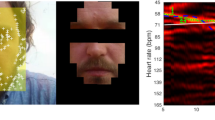Abstract
The photoplethysmography (PPG) sensor can be applied to measure the situation and function of human blood circulation. The PPG sensor is not only existed the characteristics of simple, convenient and low price but also easy non-invasive to measure physiological signal. The advantage of PPG signal is easy to measure from various sensing location. The physiological information of the clinical detection method is broadly implemented for such type. In this paper, we utilize “the green LED reflective” PPG sensor to capture physiological signals operated in static and exercise modes. Therefore, we adopted the short-term measurement in 5 min. Those captured signals are divided into five segments and 1 min for each segment. We calculated heart beats per minute and heart rate variability (HRV) operated in time domain analysis criteria. The related theory of short-time Fourier transform (STFT) combined with power spectral density (PSD) is implemented for finding HRV in frequency domain analysis. Then, we derived random process theory and the autocorrelation function which are verified the PPG measurement is stationary process or not. In the future experiment, we can compare the 24 h data with the previous results. Consequently, we apply the physical health status monitoring of long-term and short-term modes to observe subject varies of HRV and ANS after listening music concurrently.























































































Similar content being viewed by others
References
Fu, T.-H. (2010). Application of time–frequency analysis of infrared plethysmograph waveform. International Journal of Advanced Information Technologies, 4(6), 105–118.
Weng, K.-P., Ho, T.-Y., Ou, S.-F., Lin, C.-C., & Hsieh, K.-S. (2009). Analysis of heart rate variability. Taiwan Medical Journal, 52(6), 12–13.
Liu, S.-H., Chang, K.-M., & Fu, T.-H. (2010). Heart rate extraction from photoplethysmogram on fuzzy logic discriminator. Journal of Engineering Applications of Artificial Intelligence, 23(9), 968–977.
Li, X.-E., Fang, J.-C., & Li, Y.-D. (2009). Measurement and analysis of PPG signal (pp. 4–7). Taichung: Feng Chia University.
Pulse Sensor V4.4. http://share.eepw.com.cn/share/download/id/382273.
Appel, L. J., Brands, M. W., Daniels, S. R., Karanja, N., Elmer, P. J., & Sacks, F. M. (2006). Dietary approaches to prevent and treat hypertension: a scientific statement from the American Heart Association. Hypertension, 47, 296.
Boundless. Introduction to Blood Pressure. Boundless Anatomy and Physiology. Boundless, 21 July 2015. Retrieved 27 Jan 2016.
Blood Pressure UK. http://www.bloodpressureuk.org/.
Datasheet of AM2520ZGC09. https://www.kingbrightusa.com/images/catalog/spec/AM2520ZGC09.pdf.
Datasheet of APSD-9008. http://www.avagotech.com/docs/AV02-1169EN.
Datasheet of MCP6001. http://ww1.microchip.com/downloads/en/devicedoc/21733j.pdf.
Guyomard, J., & Stortelder, R. (2015). Heart rate measurement through PPG: Heartbeat measurement in a wireless headset (pp. 5–6). Delft: The Delft University of Technology.
LabVIEW STFT Spectrograms VI. http://zone.ni.com/reference/en-XX/help/371361J-01/lvanls/stft_spectrogram_core/.
Liangfang, Y.I.N., Yuanqing, X.I.A.O., Zhenyu, X.U. (2013). A new principle based on Pearson correlation coefficient to avoid mal-operation of the restricted earth fault protection. In 22nd international conference on electricity distribution Stockholm.
Malik, M. (1996). Heart rate variability. European Heart Journal, 444, 354–381.
Kautzner, J. (1995). Reproducibility of heart rate variability measurement. In M. Malik & A. J. Camm (Eds.), Heart rate variability (pp. 165–171). Armonk: Futura Publishing Co., Inc.
Kamath, M. V., Watanabe, M. A., & Upton, A. R. M. (2011). Heart rate variability: A historical perspective. Department of Physiology and Cell Biology, the Ohio State University Columbus, OH, USA. Frontiers in Physiology, 2(86), 86. doi:10.3389/fphys.2011.00086.
Mayo Clinic. http://www.mayoclinic.org/.
MEDICORE. Heart rate variability analysis system. http://medi-core.com/download/HRV_clinical_manual_ver3.0.pdf. Accessed 16 March 2015.
Moissl, U., Garzotto, F., Signorini, M. G., Cruz, D., Tetta, C., Ronco, C., Gatti, E., & Cerutti, S. (2010) Study of the autonomic response in hemodialysis patients with different fluid overload levels. In Annual international conference of the IEEE, engineering in medicine and biology society (EMBC) (pp. 3796–3799).
Pearson correlation coefficient. https://zh.wikipedia.org/wiki/Pearson_product-moment_correlation_coefficient.
Peng, R.-C., Zhou, X.-L., Lin, W.-H., & Zhang, Y.-T. (2015). Extraction of heart rate variability from smartphone photoplethysmograms. Computational and Mathematical Methods in Medicine, 2015, 11. (Article ID 516826).
Samuel & Mueller, D. The circulatory system. http://carignanapbio.weebly.com/circulatorysystem.html.
Schwa, P. J., & Stone, H. L. (1982). The role of the autonomic nervous system in sudden coronary death. Annals of the New York Academy of Sciences, 382, 162–180.
Systolic & Diastolic Blood Pressure. http://www.diffen.com/.




